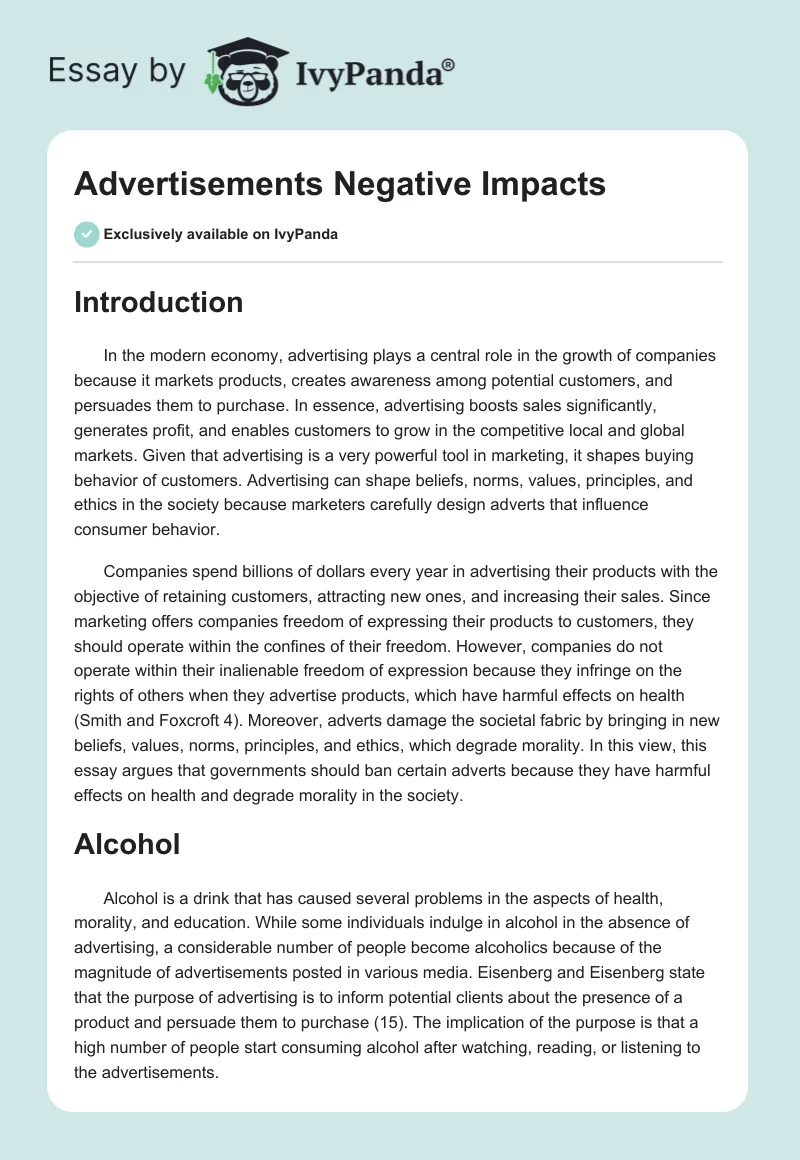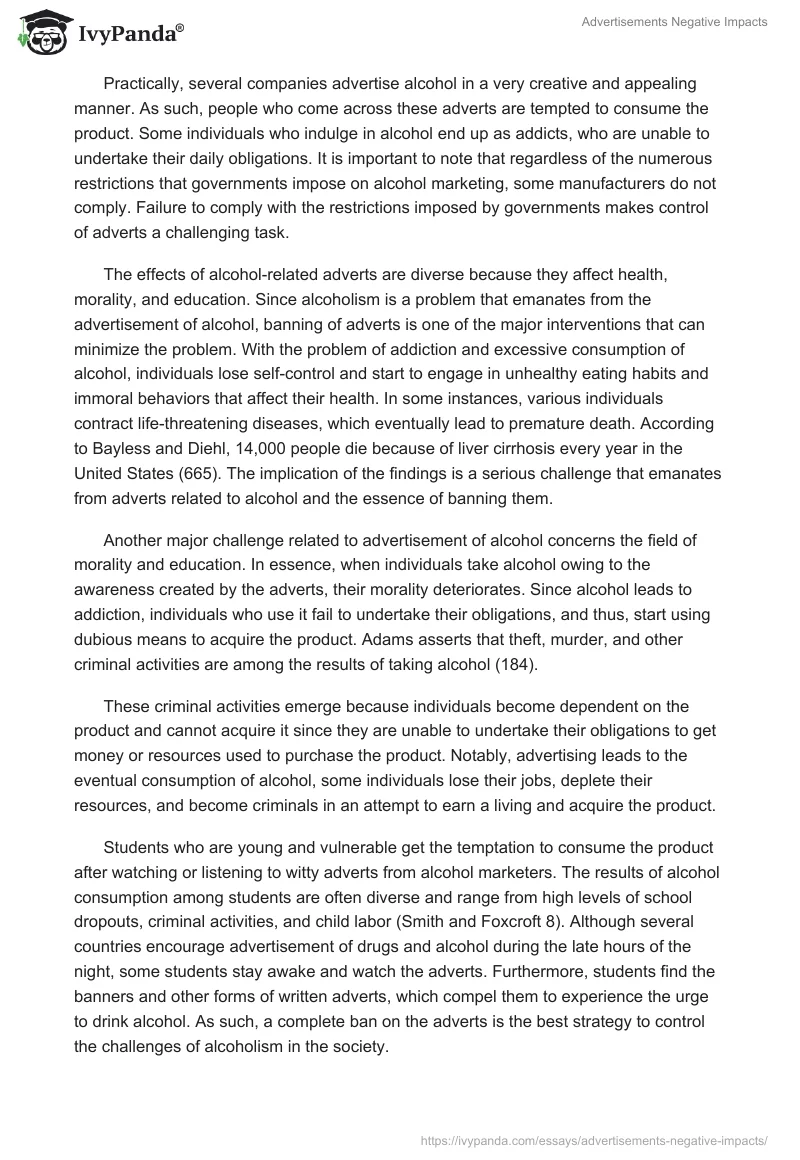Introduction
In the modern economy, advertising plays a central role in the growth of companies because it markets products, creates awareness among potential customers, and persuades them to purchase. In essence, advertising boosts sales significantly, generates profit, and enables customers to grow in the competitive local and global markets. Given that advertising is a very powerful tool in marketing, it shapes buying behavior of customers. Advertising can shape beliefs, norms, values, principles, and ethics in the society because marketers carefully design adverts that influence consumer behavior.
Companies spend billions of dollars every year in advertising their products with the objective of retaining customers, attracting new ones, and increasing their sales. Since marketing offers companies freedom of expressing their products to customers, they should operate within the confines of their freedom. However, companies do not operate within their inalienable freedom of expression because they infringe on the rights of others when they advertise products, which have harmful effects on health (Smith and Foxcroft 4). Moreover, adverts damage the societal fabric by bringing in new beliefs, values, norms, principles, and ethics, which degrade morality. In this view, this essay argues that governments should ban certain adverts because they have harmful effects on health and degrade morality in the society.
Alcohol
Alcohol is a drink that has caused several problems in the aspects of health, morality, and education. While some individuals indulge in alcohol in the absence of advertising, a considerable number of people become alcoholics because of the magnitude of advertisements posted in various media. Eisenberg and Eisenberg state that the purpose of advertising is to inform potential clients about the presence of a product and persuade them to purchase (15). The implication of the purpose is that a high number of people start consuming alcohol after watching, reading, or listening to the advertisements.
Practically, several companies advertise alcohol in a very creative and appealing manner. As such, people who come across these adverts are tempted to consume the product. Some individuals who indulge in alcohol end up as addicts, who are unable to undertake their daily obligations. It is important to note that regardless of the numerous restrictions that governments impose on alcohol marketing, some manufacturers do not comply. Failure to comply with the restrictions imposed by governments makes control of adverts a challenging task.
The effects of alcohol-related adverts are diverse because they affect health, morality, and education. Since alcoholism is a problem that emanates from the advertisement of alcohol, banning of adverts is one of the major interventions that can minimize the problem. With the problem of addiction and excessive consumption of alcohol, individuals lose self-control and start to engage in unhealthy eating habits and immoral behaviors that affect their health. In some instances, various individuals contract life-threatening diseases, which eventually lead to premature death. According to Bayless and Diehl, 14,000 people die because of liver cirrhosis every year in the United States (665). The implication of the findings is a serious challenge that emanates from adverts related to alcohol and the essence of banning them.
Another major challenge related to advertisement of alcohol concerns the field of morality and education. In essence, when individuals take alcohol owing to the awareness created by the adverts, their morality deteriorates. Since alcohol leads to addiction, individuals who use it fail to undertake their obligations, and thus, start using dubious means to acquire the product. Adams asserts that theft, murder, and other criminal activities are among the results of taking alcohol (184).
These criminal activities emerge because individuals become dependent on the product and cannot acquire it since they are unable to undertake their obligations to get money or resources used to purchase the product. Notably, advertising leads to the eventual consumption of alcohol, some individuals lose their jobs, deplete their resources, and become criminals in an attempt to earn a living and acquire the product.
Students who are young and vulnerable get the temptation to consume the product after watching or listening to witty adverts from alcohol marketers. The results of alcohol consumption among students are often diverse and range from high levels of school dropouts, criminal activities, and child labor (Smith and Foxcroft 8). Although several countries encourage advertisement of drugs and alcohol during the late hours of the night, some students stay awake and watch the adverts. Furthermore, students find the banners and other forms of written adverts, which compel them to experience the urge to drink alcohol. As such, a complete ban on the adverts is the best strategy to control the challenges of alcoholism in the society.
Tobacco
Banning tobacco related adverts is fundamental reducing the number of people who consume tobacco and experience related problems. Findings demonstrate a rise in the number of tobacco consumers in the United States is due to advertising (Bottorff et al. 6). The rising number of tobacco consumers relates to the high level of advisements witnessed in the recent past. In their creative adverts, several marketers focus on the advantages that are untrue in most cases and downplay the problems that result from tobacco consumption.
As a result, various individuals engage in the consumption of tobacco after getting knowledge on the advantages, and in turn end up managing the problems associated with addiction. In an attempt to increase their revenues and outsmart their competitors, tobacco manufacturers and marketers have intensified the level of advertisements, and thus, several individuals remain tempted to consume the product.
Notably, tobacco has various diseases related to its consumption that include asthma, bronchitis, lung cancer, and emphysema. Tobacco is very addictive, and thus, its consumption leads to addiction, a condition that makes smokers consume several cigarettes on a daily basis. Smith and Foxcroft explain that the number of deaths associated with tobacco consumption is increasing owing to advertising (5). The increasing number of deaths resulting from the use of tobacco implies that several families will continue losing their loved ones if states or governments do not ban tobacco adverts.
Morality and education are also the fields that experience serious challenges that originate from the use of tobacco. Since the chief focus of marketers is to increase their revenues and market share, the majority downplay the essence of informing their potential clients about the effects of smoking (Eisenberg and Eisenberg 14). Practically, several tobacco adverts leave very little space for information concerning the effects of tobacco. As a result, various individuals consume the product naively without learning about the consequences of its consumption. Moreover, several adverts educate individuals regarding the benefits of tobacco consumption; however, these benefits are often untrue and baseless.
For instance, tobacco marketers produce adverts that present consumers as successful and presentable individuals. However, the reality is that tobacco consumption has negative outcomes. After consuming tobacco, several individuals become addicts for they rely on it for their bodies to function normally. In the absence of the product, cigarette smokers engage in a number of criminal activities to acquire money for buying tobacco. Some of the activities that emanate from the use of tobacco can be theft, murder, drug abuse, and other immoral activities (Morizot and Kazemian 383). The acts that are not morally upright result from the high levels of addiction and dependency, which hamper the productivity of individuals.
Learning institutions are among the areas affected by the intensified tobacco advertisements. Students are usually vulnerable, and therefore, adverts related to tobacco increase their willingness to purchase and smoke tobacco. The high vulnerability occurs because most of the students are young and cannot make informed or rational decisions. When students come across banners or written materials that advertise tobacco, they are tempted to consume and experience claims of adverts. Tobacco smoking among students often leads to school dropout, reduced academic performance, rudeness, and stress in families (Smith and Foxcroft 7). By banning tobacco adverts, governments greatly minimize the effects associated with health, morality, and education.
Conclusion
Advertisements play an important role in modern societies. Marketers often use adverts to persuade potential consumers to purchase and consume their products. While several adverts market products that improve the well-being of people in the society, others are annoying and have negative outcomes. Some adverts affect health, morality, and education of individuals in the society. Adverts, which promote the use of alcohol and tobacco, are among the annoying adverts. To minimize the negative impacts of adverts and improve health, morality, and education in the society, governments need to ban annoying adverts.
Works Cited
Adams, Robert. Foundations of Health and Social Care. London: Macmillan, 2007. Print.
Bayless, Theodore, and Anna Diehl. Advanced Therapy in Gastroenterology and Liver Disease. Hamilton: Decker, 2005. Print.
Bottorff, Joan, Rebecca Haines-Saah, Mary Kelly, John Oliffe, Iris Torchalla, Nancy Poole, Lorraine Greaves, Carole Robinson, Mary Ensom, Chizimuzo Okoli, and Craig Phillips. “Gender, smoking and tobacco reduction and cessation: a scoping review.” International Journal for Equity in Health 13.114 (2014): 1-15. Print.
Eisenberg, Bryan, and Jeffrey Eisenberg. Waiting for Your Cat to Bark?: Persuading Customers when they Ignore Marketing. New York: Thomas Nelson Inc, 2007. Print.
Morizot, Julien, and Lila Kazemian. The Development of Criminal and Antisocial Behavior: Theory, Research, and Practical Applications. New York: Springer, 2015. Print.
Smith, Leslie, and David Foxcroft. “The Effect of Alcohol Advertising, Marketing, and Portrayal on Drinking Behavior in Young People: Systematic Review of Prospective Cohort Studies.” BMC Public Health 9.51 (2010): 1-11. Print.


